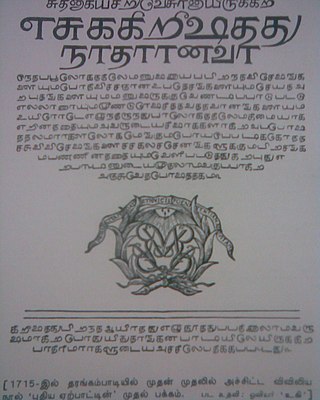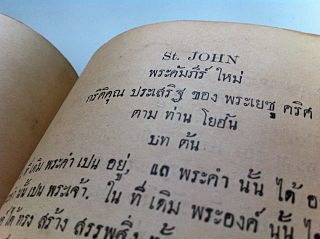List of Translations
In 1821, the Serampore Mission published the first New Testament in “The Nepala Language” as “Vol. V” of a full Bible that was never completed. [4] Digital scans of this New Testament are available online.
In 1902, the Calcutta Auxiliary Bible Society published a New Testament composed of eleven parts which had been previously published independently. Ganga Prasad Pradhan was the main Nepali translator. [3]
In 1914, the Calcutta Auxiliary Bible Society published an Old Testament. Ganga Prasad Pradhan was the main Nepali translator. [3] In 2014, this Old Testament was reprinted based on photographs of the original as a "Special Centennial Edition of the Nepali Bible Translation" by the Nepal Bible Society. [5]
In 1946, the Bible Society of India and Ceylon, Calcutta Auxiliary, with the British and Foreign Bible Society published a New Testament. Digital scans of this New Testament are available online.
In 1977, the Bible Society of India, Bangalore published a complete Nepali Bible called the Revised Version (RV) in one volume. [4]
In 1980, the Bible Society in Nepal published a Common Language New Testament, marking the first time Nepali Scriptures were published inside of Nepal. [3]
In 1997, the Nepal Bible Society published a complete Bible called the Nepali New Revised Version (NNRV), which has become the Bible most popular in Nepali churches. [6] This version is available online.
In 1998, the International Bible Society (now Biblica, Inc.) published a New Testament called the Nepali Contemporary Version. This version is available online.
In 1999, the Bellarmine Institute of Language in Darjeeling published The Complete Catholic Bible in Nepali, the first Nepali Bible to include the 73-book canon recognized by the Catholic Church. [7] [8]
In 2004, the World Bible Translation Center Bangalore published a complete Nepali Bible called the Easy to Read Version (ERV). This version is available online.
In 2008, the Nepal Bible Society published a complete Bible called the Simple Nepali Holy Bible. This version is available online.
In 2010, the New Testament of New World Translation of the Holy Scriptures was released by Jehovah's Witnesses in Nepali. It was published online (also offline in PDF format) with mobile versions released through JW Library application in App stores.
In 2011, the Trinitarian Bible Society published a complete Bible. [1] Only the Gospel of John from this translation is available online.
In 2018, complete New World Translation of the Holy Scriptures was released by Jehovah's Witnesses in Nepali. It is available on jw.org, Watchtower Online Library and through JW Library application in App stores.
In 2019, Door43 World Missions Community published a complete Bible called the Unlocked Literal Bible. This translation is available online.
Related Research Articles

The Trinitarian Bible Society was founded in 1831 "to promote the Glory of God and the salvation of men by circulating, both at home and abroad, in dependence on the Divine blessing, the Holy Scriptures, which are given by inspiration of God and are able to make men wise unto salvation through faith which is in Christ Jesus."

Bible translations into Chinese include translations of the whole or parts of the Bible into any of the levels and varieties of the Chinese language. The first translations may have been made as early as the 7th century AD, but the first printed translations appeared only in the nineteenth century. Progress on a modern translation was encumbered by denominational rivalries, theological clashes, linguistic disputes, and practical challenges at least until the publication of the Protestant Chinese Union Version in 1919, which became the basis of standard versions in use today.
The Ilocano Bible, published in 1909, is the second Bible to be published in any Philippine language, after the Tagalog which was published in 1905.

There are two main translations of the Bible into Japanese widely in use today—the New Interconfessional Version and the New Japanese Bible. New Interconfessional Translation Version is published by the Japan Bible Society and the New Japanese Bible is published by Inochinokotoba-sha. The New Japanese Version aims to be used as a literal translation using modern Japanese while the New Interconfessional Version aims to be ecumenically used by all Christian denominations and must therefore conform to various theologies. Protestant Evangelicals most often use the New Japanese Version, but the New Interconfessional Version is the most widely distributed and the one used by the Catholic Church, the United Church of Christ, Lutheran Church factions and many Anglicans in Japan.
The Serampore Mission Press was a book and newspaper publisher that operated in Serampore, Danish India, from 1800 to 1837.
The earliest preserved translation of the Bible into the Mongolian language dates to 1827, but there is a written record of what may perhaps have been a translation existing as early as 1305. Since 1827, numerous other translations have been made.
Bible translations into Persian have been made since the fourth or fifth century, although few early manuscripts survive. There are both Jewish and Christian translations from the Middle Ages. Complete translations of the Hebrew Bible and Greek New Testament from original languages were first made in the 19th century by Protestant missionaries.
The modern Vietnamese alphabet chữ Quốc ngữ was created by Portuguese and Italian Jesuit missionaries and institutionalized by Alexandre de Rhodes with the first printing of Catholic texts in Vietnamese in 1651, but not the Bible. Some New Testament extracts were translated and printed in catechisms in Thailand in 1872.
Translation of the Bible into Malayalam began in 1806. Church historians say Kayamkulam Philipose Ramban, a scholar from Kayamkulam, translated the Bible from Syriac into Malayalam in 1811 to help the faithful get a better understanding of the scripture. The Manjummal translation is the first Catholic version of the Bible in Malayalam. This is the direct translation from Latin. The four Gospels and the Acts of the Apostles were translated by the inmates of the Manjummal Ashram, Fr. Aloysius, Fr. Michael and Fr. Polycarp. The Pancha Granthy came out from Mannanam under the leadership of Nidhirikkal Mani Kathanar in 1924. The Catholic New Testament was published in full in 1940. and has influenced development of the modern language.
The first Marathi translation was made by Vaidyanath Sarma under the supervision of the Serampore missionaries and William Carey at Fort William College. However Carey's translation was found lacking, and was revised by two American missionaries, Gordon Hall and Samuel Newell in 1826, with a subsequent edition in 1830. Further, David Oliver Allen "superintended a translation of the Scriptures into the Mahratta language" while in charge of the Bombay printshop 1844−53.

The modern Hindi language and Urdu language are mutually intelligible in colloquial form, but use different scripts when written, and have mutually intelligible literary forms. The history of Bible translations into Hindi and Urdu is closely linked, with the early translators of "Hindustani" simply producing the same version with different scripts: Devanagari and Nastaliq, as well as Roman.

The history of Bible translations into the Tamil language commences with the arrival of Bartholomäus Ziegenbalg at Tranquebar in 1706.Johann Philipp Fabricius, a German, revised Ziegenbalg's and others work to produce the standard Tamil version. Seventy years after Fabricius, at the invitation of Peter Percival a Saiva scholar, Arumuka Navalar, produced a "tentative" translation, which is known as the "Navalar version," and was largely rejected by Tamil Protestants.
The first attempt to translate Bible into Kannada was by the Serampore missionaries and they appear to have it completed by 1809. However this manuscript was lost in the 1812 fire at the Serampore press.
Biblical translations into the indigenous languages of North and South America have been produced since the 16th century.
Languages spoken in the Indian Subcontinent belong to several language families, the major ones being the Indo-Aryan languages spoken by 75% of Indians and the Dravidian languages spoken by 20% of Indians. Other languages belong to the Austroasiatic, Sino-Tibetan, Tai-Kadai, and a few other minor language families and isolates. India has the world's second-highest number of languages (780), after Papua New Guinea (839). The first known translation of any Christian Scripture in an Indian language was done to Konknni in 1667 AD by Ignazio Arcamone, an Italian Jesuit.

Bible translations into the languages of Indonesia and Malaysia have a lot of common history up until the modern era. Apart from the shared Malay language which historically was the lingua franca of the Malay archipelago and forms the basis for the national languages of Indonesia and Malaysia today, portions of the Bible have been translated into a variety of indigenous languages in the region.

The entire Bible was published in Thai in 1894 and there are currently several translations of the Bible in the Thai language.
Ganga Prasad Pradhan was born on July 4, 1851 in Kathmandu and was the first ordained Nepali Christian pastor, main translator of the Nepali Bible, co-author of an English-Nepali dictionary and author of children's textbooks.
G. D. V. Prasad is an Old Testament scholar and translator who was the Director of Translations at the Bible Society of India, Bangalore, from 1991 to 2010. Prasad is from the Diocese of Krishna-Godavari of the Church of South India.

Parasmani Pradhan was an Indian Nepali-language writer, poet, translator, grammarian, educator and publisher. He published multiple Nepali language textbooks and played an important role in shaping the modern Nepali grammar. He was one of the key figures who contributed in establishing Nepali as one of the official language of India.
References
- 1 2 "Nepali". Trinitarian Bible Society. September 13, 2022. Retrieved September 27, 2022.
{{cite web}}: CS1 maint: url-status (link) - ↑ Carey, W., J. Marshman and W. Ward. Ninth Memoir Respecting the Translations and Editions of the Sacred Scriptures, Conducted by the Serampore Missionaries. Serampore, 1822.
- 1 2 3 4 5 6 Perry, Cindy. A Biographical History of the Church in Nepal. 3rd Edition. Kathmandu: Nepal Church History Project, 2000.
- 1 2 Lindell, Jonathan. Nepal and the Gospel of God. Kathmandu: United Mission to Nepal, 1979.
- ↑ The Holy Bible: Centennial Edition of the Nepali Bible Translation. Nepal Bible Society. 2014. ISBN 9789937864848.
- ↑ Nepali Bible Reviews : Nepali Bible Translations / Versions | Best Nepali Bible , retrieved 2022-09-27
- ↑ Bourke, William, ed. (1999). The Complete Catholic Bible in Nepali. Convent Road, Darjeeling: Bellarmine Institute of Language.
- ↑ "Meet William Bourke, the Canadian who wrote the first comprehensive Nepali thesaurus". The Globe and Mail .